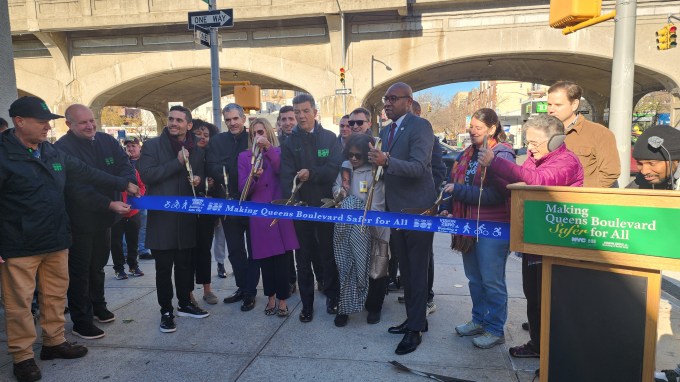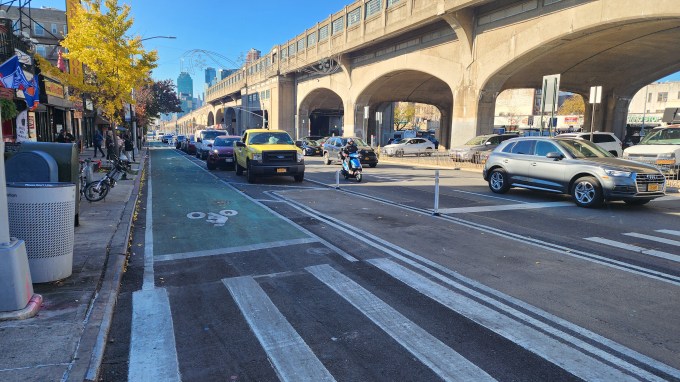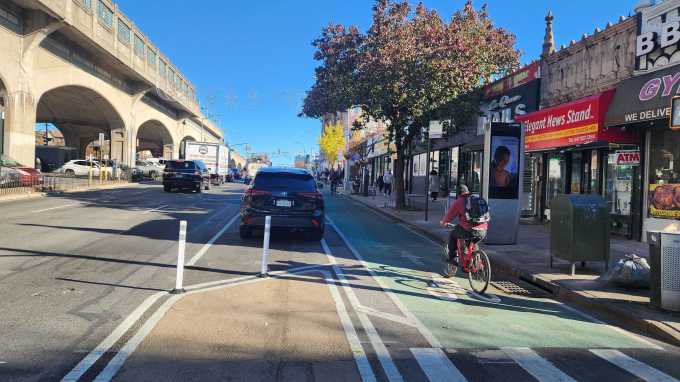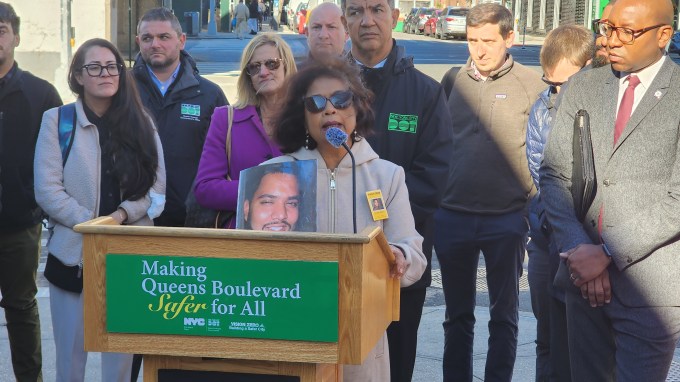
DOT officials, elected officials and transportation advocates cut the ribbon for the Queens Boulevard Redesign. Photo: Shane O’Brien
Nov. 12, 2024 By Shane O’Brien
Department of Transportation representatives and elected officials gathered in Sunnyside Tuesday afternoon to announce the completion of the sixth and final phase of the Queens Boulevard Redesign, which has resulted in a 68% decline in fatalities along the boulevard since work began in 2015.
NYC DOT Commissioner Ydanis Rodriguez, Queens Borough President Donovan Richards, and numerous transportation advocates gathered at 40-20 Queens Blvd. on Tuesday to celebrate the completion of the final stretch of the Queens Boulevard Redesign, which stretches from Skillman Avenue to Roosevelt Avenue.
The newly redesigned boulevard includes parking-protected curbside bike lanes to enhance cyclist safety, pedestrian islands to shorten crossing distances while also encouraging drivers to take slower, safer turns, and additional adjustments to traffic signal timing to allow more time for pedestrian crossings before lights turn green.

Protected bike lane on the newly redesigned Queens Boulevard. Photo: Shane O’Brien
Rodriguez said the measures have helped turn Queens Boulevard from the “Boulevard of Death” into the “Boulevard of Life,” stating that there has been a 35% reduction in traffic-related injuries since the redesign began in 2015 as well as a 68% reduction in fatalities.
The completion of the final phase of the redesign creates a seven-mile, multi-modal stretch between Queens Plaza and Hillside Avenue. Queens Boulevard now features the longest continuous stretch of protected bike lanes on a New York City street.
Meanwhile, the final phase of the redesign features eight-foot-wide bike lanes, which are about two feet wider than standard protected bike lanes in the city. These lanes are designed to better accommodate bikes and e-bikes traveling at different speeds and side-by-side social cycling. The DOT says 351 traffic injuries were recorded along the mile-long stretch covered by the final phase of the redesign between 2019 and 2023.
Rodriguez said the entire redesign project has converted one of the most dangerous thoroughfares in the city into a “street that is safer for everyone.”
“All New Yorkers from all walks of life deserve safe connections and transportation options,” Rodriguez said. “No one should have to feel like they are putting their life at risk to cross the street in their own neighborhood.”

Protected bike lane on the newly redesigned Queens Boulevard. Photo: Shane O’Brien
The redesign was implemented as part of New York City’s Vision Zero initiative, a program originally introduced in 2014 by then-Mayor Bill de Blasio that aims to eliminate all traffic-related fatalities and injuries in the city.
Rodriguez said the completion of the redesign is a “milestone” for the Vision Zero initiative and a reminder that street redesign saves lives.
“These are not just numbers. These are real people. They could be our friends, our loved ones, or our neighbors who are alive today or who didn’t suffer life-changing injuries because of how this street was redesigned,” Rodriguez said. “I’m proud to say that Queens Boulevard is not the Boulevard of Death anymore, but the Boulevard of Life.”
Richards said the completion of the Queens Boulevard Redesign marked a “great afternoon for Queens”, stating that what was formerly known as the Boulevard of Death had been “completely transformed”.
“All of these improvements are going to go a long way towards preventing the kinds of tragedies that earned this busy thoroughfare its unwanted nickname,” Richards said on Tuesday. “There have been far too many tragedies along this Boulevard, and each death that has occurred here has snuffed out a promising life far too soon and has caused tremendous pain for the loved ones of those lost.
“We don’t want any more tragedies to happen here or any other part of Queens.”
Rodriguez also announced Tuesday that the DOT will now seek to upgrade the original redesign with concrete materials to ensure its long-lasting future.
The DOT will next upgrade the section of Queens Boulevard it first redesigned in 2015 from Roosevelt Avenue to 73rd Street. The upgrades, which will cost an estimated $150 million, will be partially funded by $23.7 million in federal funding and $1.5 million in funding sourced by Richards and Council Member Julie Won.

Protected bike lane on the newly redesigned Queens Boulevard. Photo: Shane O’Brien
The upgrades include a reconstructed road median featuring a raised pedestrian mall and grade-separated bike path; improved accessibility at all bus stops; a planted buffer and vertical barrier to protect pedestrians from traffic; additional lighting, public seating, and landscaping; and the reconfiguration of several slip ramps to improve safety for all road users, reduce crossing distances, and create calmer, more predictable driving behavior.
Rodriguez said the upgrades would add “concrete improvement” to the redesign, replacing painted bike lanes and traffic islands introduced as part of the original redesign nine years ago with concrete-protected bike lanes.
“That means the painted bike lanes will be filled up with a curb and that many of the other painted elements will be filled with concrete,” Rodriguez said at Tuesday’s announcement. “If we can achieve a 68% decrease in traffic fatalities using just our short-term toolkit of paint and plastic, imagine what we can achieve when we bring concrete improvement to a corridor like this.”
Richards added that there is still work to do to reduce the number of fatalities and injuries along Queens Boulevard and that the work will not be concluded until there are no traffic-related deaths along the thoroughfare.
“The next phase of this work will make this section of Queens Boulevard even safer than it is today, and that’s important because even one death or serious injury along this roadway is too many,” Richards said.
Lizi Rahman, whose 22-year-old son Asif was killed while riding a bike on Queens Boulevard in 2008, welcomed the conclusion of the redesign, stating that her son’s death didn’t go in vain.
“I knew I wouldn’t get my son back, but I knew that it would save people – sons like my son so that other mothers don’t go through the pain that I was going through,” Rahman said while holding a picture of her son Asif aloft.

Lizi Rahman holds a photograph of her son Asif during Tuesday’s rally. Photo: Shane O’Brien
After Tuesday’s press conference, Rodriguez faced questions about enforcement of illegal parking in the new bike lanes. Advocates for the new bike lanes pointed to two cars parked in a bike lane just 50 feet from the press conference, including one NYPD vehicle.
Rodriguez, however, wanted to focus on the achievement of completing the Queens Boulevard Redesign and said the DOT would address finer details surrounding enforcement in the near future.
“We are celebrating all the great work of Queens Boulevard being transformed from the Boulevard of Death into the Boulevard of Life,” he said. “Any other thing that may happen, definitely we will address it.”
Rodriguez also believes that the redesign will encourage more people to cycle along Queens Boulevard and protect cyclists and pedestrians. He noted that the number of bike trips in New York City more than doubled between 2009 and 2023, jumping from 98 million to over 200 million in the 14-year interval.
“Biking is a human right, and biking is good for the economy and it’s good for the environment,” he said. “If you build it, cyclists will come… if we build the infrastructure, families will know that it’s safe for them to ride bikes with their children.
“When we build safer and healthy streets, we see New Yorkers living safer and healthier lives too.”
5 Comments

First of all, this is not a bike lane. It’s an electric vehicle lane that is used more for commercial purposes than leisure. Second. It makes Queens Boulevard more dangerous for pedestrians, as they have to walk INTO a bike lane to cross the street. How about designing protected Pedestrian lanes.
These bike lanes are a complete waste of tax payer dollars. Legislation should be introduced for everyone over the age of 18 to take some form of cyclist defensive course and mandate that they pay some form of insurance. But no no no it will cause a stir to certain group of people. I will continue to double park when i need to in the bike lanes
Love to see it. Very positive move for our section of the Boulevard!
I wish the drivers would respect the lanes. I walking by 39th and Queens Blvd at 7:30 in the morning and a truck was parked in the bike lane and unloading tons of boxes.
a boulevard is not for bikes. just because you paint a bike lane that nobody uses doesnt mean anything.